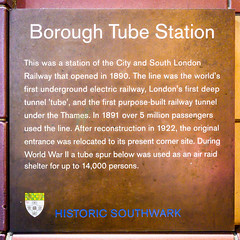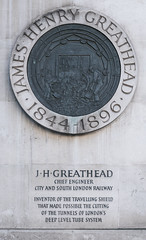City and South London Railway
Commemorated on 3 plaques
Site of King William Street Underground Station first city terminus 1890-1900
Monument Street, London, United Kingdom where it was
Borough Tube Station This was a station of the City and South London Railway that opened in 1890. The line was the world's first underground electric railway, London's first deep tunnel 'tube', and the first purpose-built railway tunnel under the Thames. In 1891 over 5 million passengers used the line. After reconstruction in 1922, the original entrance was relocated to its present corner site. During World War II a tube spur below was used as an air raid shelter for up to 14,000 persons.
Borough High Street, London, United Kingdom where it was
J. H. Greathead Chief Engineer City and South London Railway. Inventor of the Travelling Shield that made possible the cutting of the tunnels of London's deep level tube system
Cornhill, London, United Kingdom where it was




